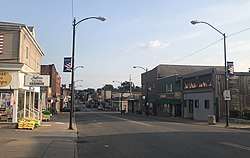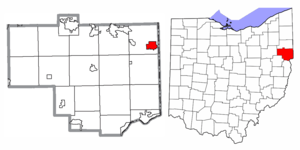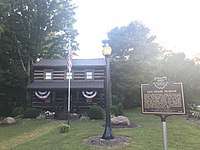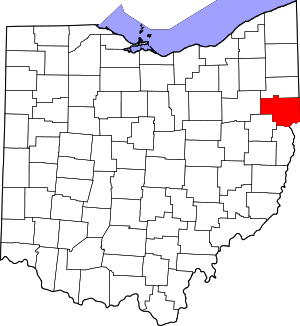East Palestine, Ohio
East Palestine (/ˌpæləˈstiːn/ PAL-ə-STEEN) is a village in eastern Columbiana County, Ohio, United States. The population was 4,721 at the 2010 census. Located on the state's border with Pennsylvania, East Palestine is 20 miles (32 km) south of Youngstown and 50 miles (80 km) northwest of downtown Pittsburgh. East Palestine is located in the Salem, OH Micropolitan Statistical Area, as well as the southern part of the greater Mahoning Valley.
East Palestine, Ohio | |
|---|---|
| Village of East Palestine | |
 Businesses along Market Street in Downtown | |
| Motto(s): "Where You Want To Be" | |
 Location of East Palestine in Columbiana County and the State of Ohio | |
| Coordinates: 40°50′7″N 80°32′31″W | |
| Country | United States |
| State | Ohio |
| County | Columbiana |
| Government | |
| • Type | Council-Manager |
| • Mayor | Trent R. Conaway (I)[1] |
| • Village Manager | Mark McTrustry |
| Area | |
| • Total | 3.15 sq mi (8.16 km2) |
| • Land | 3.15 sq mi (8.16 km2) |
| • Water | 0.00 sq mi (0.00 km2) |
| Elevation | 1,001 ft (305 m) |
| Population (2010) | |
| • Total | 4,721 |
| • Estimate (2019)[4] | 4,424 |
| • Density | 1,403.55/sq mi (541.97/km2) |
| Time zone | UTC-5 (Eastern (EST)) |
| • Summer (DST) | UTC-4 (EDT) |
| ZIP code | 44413 |
| Area code(s) | 330, 234, 878 |
| FIPS code | 39-23940[5] |
| GNIS feature ID | 1064586[3] |
| School District | East Palestine City |
| Website | http://www.eastpalestine-oh.gov/ |
East Palestine is located along the Norfolk Southern Railway, and has a freight train station.[6] From the 1870s until the mid 1960s, East Palestine was home to a large industry in ceramics and tire manufacturing. Since then, it has relied on its close proximity to industries in the metropolitan areas of Youngstown and Pittsburgh.
History

East Palestine was founded in 1828 as Mechanicsburg, and incorporated as a village in 1875 as East Palestine.[7] The name was changed as part of the religious nomenclature in the area, including communities such as Enon Valley and New Galilee. Palestine, Ohio was already an incorporated community.[8] Having reached a population of 5,000, East Palestine operated as a statutory city from 1920 until 2011, when it reverted to village status due to declining population.
By the 1920s, railroad facilities of the city consisted of the four track Pennsylvania system. Switches from the Pittsburgh, Lisbon and Western Railroad within one mile of the corporation limits connected with the Pittsburgh and Lake Erie Railroad and New York Central Railroad. The city's leading industries were the manufacture of pottery and automobile tires by the W. S. George Pottery Company and the Edwin C. McGraw Tire Company. However, factories existed that produced steel tanks, foundry work, electrical refractories, food products, electric wiring devices, wooden ventilators, fire proofing material, synthetic ice, and lumber. Around this time, East Palestine began to start an economy in orcharding, which still survives today. Large storage and preserving facilities made East Palestine the leading city for orchards in the area.[9]
Geography
East Palestine is located along the eastern boundary of Columbiana County, almost touching Darlington Township, Pennsylvania. The village is part of Unity Township.
The following highways pass through East Palestine:
According to the United States Census Bureau, East Palestine has a total area of 3.15 square miles (8.16 km2), all land.[10][11]
Demographics
| Historical population | |||
|---|---|---|---|
| Census | Pop. | %± | |
| 1880 | 1,047 | — | |
| 1890 | 1,816 | 73.4% | |
| 1900 | 2,493 | 37.3% | |
| 1910 | 3,537 | 41.9% | |
| 1920 | 5,750 | 62.6% | |
| 1930 | 5,215 | −9.3% | |
| 1940 | 5,123 | −1.8% | |
| 1950 | 5,195 | 1.4% | |
| 1960 | 5,232 | 0.7% | |
| 1970 | 5,604 | 7.1% | |
| 1980 | 5,306 | −5.3% | |
| 1990 | 5,168 | −2.6% | |
| 2000 | 4,917 | −4.9% | |
| 2010 | 4,721 | −4.0% | |
| Est. 2019 | 4,424 | [4] | −6.3% |
| U.S. Decennial Census[12] | |||
2010 census
As of the census[13] of 2010, there were 4,721 people, 1,898 households, and 1,282 families living in the city. The population density was 1,498.7 inhabitants per square mile (578.7/km2). There were 2,125 housing units at an average density of 674.6 per square mile (260.5/km2). The racial makeup of the city was 98.2% White, 0.2% African American, 0.1% Native American, 0.3% Asian, 0.4% from other races, and 0.7% from two or more races. Hispanic or Latino of any race were 0.9% of the population.
There were 1,898 households, of which 29.7% had children under the age of 18 living with them, 49.4% were married couples living together, 13.3% had a female householder with no husband present, 4.8% had a male householder with no wife present, and 32.5% were non-families. 27.3% of all households were made up of individuals, and 11.3% had someone living alone who was 65 years of age or older. The average household size was 2.46 and the average family size was 2.95.
The median age in the city was 40.7 years. 23.1% of residents were under the age of 18; 7.6% were between the ages of 18 and 24; 24.3% were from 25 to 44; 28.5% were from 45 to 64; and 16.5% were 65 years of age or older. The gender makeup of the city was 49.0% male and 51.0% female.
2000 census
As of the census[5] of 2000, there were 4,917 people, 1,975 households, and 1,384 families living in the city. The population density was 1,772.1 people per square mile (685.4/km2). There were 2,108 housing units at an average density of 759.7 per square mile (293.8/km2). The racial makeup of the city was 98.47% White, 0.37% African American, 0.06% Native American, 0.14% Asian, 0.26% from other races, and 0.69% from two or more races. Hispanic or Latino of any race were 0.71% of the population.
There were 1,975 households, out of which 30.9% had children under the age of 18 living with them, 54.6% were married couples living together, 11.6% had a female householder with no husband present, and 29.9% were non-families. 25.6% of all households were made up of individuals, and 14.1% had someone living alone who was 65 years of age or older. The average household size was 2.49 and the average family size was 2.98.
In the city the population was spread out, with 24.9% under the age of 18, 7.5% from 18 to 24, 28.4% from 25 to 44, 22.6% from 45 to 64, and 16.7% who were 65 years of age or older. The median age was 38 years. For every 100 females there were 93.2 males. For every 100 females age 18 and over, there were 87.5 males.
The median income for a household in the city was $35,738, and the median income for a family was $40,057. Males had a median income of $30,550 versus $17,237 for females. The per capita income for the city was $16,243. About 5.5% of families and 10.0% of the population were below the poverty line, including 22.0% of those under age 18 and 2.2% of those age 65 or over.
Education
Children in East Palestine are served by the East Palestine City School District. The district formerly operated multiple schools throughout the city; however, a new middle school and a renovated elementary campus were erected surrounding the existing high school in 1997. The current schools in the district are:
- East Palestine Elementary School – 195 W Grant Street, grades K-4
- East Palestine Middle School – 320 W Grant Street, grades 5-8
- East Palestine High School – 360 W Grant Street, grades 9-12
Notable residents
- Linda Bolon – member of the Ohio House of Representatives from the 1st district
- Charles Burleigh Galbreath – writer, historian, educator, and librarian
- R. S. Hamilton – 33rd Speaker of the Oregon House of Representatives
- Wynn Hawkins – Major League Baseball pitcher for the Cleveland Indians
- Martha Hill – dance instructor at the Juilliard School and advocate of modern dance
- Fred Hoaglin – National Football League center for the Cleveland Browns, Baltimore Colts, Houston Oilers, and Seattle Seahawks, as well as two-time Super Bowl champion coach with the New York Giants
- Roger M. Kyes – fourth United States Deputy Secretary of Defense
- Jerry McGee – PGA Tour professional golfer
- J. T. Miller – National Hockey League left winger for the Vancouver Canucks
- Jesse R. Pitts – sociologist
- Volney Rogers – founder of Mill Creek Park
- R. J. Thomas – second president of the United Automobile Workers
References
- "2019 General Election Results for Columbiana County". Retrieved December 19, 2019.
- "2019 U.S. Gazetteer Files". United States Census Bureau. Retrieved July 28, 2020.
- "US Board on Geographic Names". United States Geological Survey. 2007-10-25. Retrieved 2008-01-31.
- "Population and Housing Unit Estimates". Retrieved May 21, 2020.
- "U.S. Census website". United States Census Bureau. Retrieved 2008-01-31.
- "Columbiana County Railroad Stations". Ohio Railroad Stations, Past & Present. Retrieved 2018-08-30.
- McCord, William B. (1905). History of Columbiana County, Ohio and Representative Citizens. Biographical Publishing Company. pp. 330–331.
- Overman, William Daniel (1958). Ohio Town Names. Akron, OH: Atlantic Press. p. 41.
- Barth, Harold B. (1926). History of Columbiana County, Ohio. Indianapolis, IN: Historical Publishing Company.
- "US Gazetteer files 2010". United States Census Bureau. Archived from the original on 2011-02-20. Retrieved 2013-01-06.
- "US Gazetteer files: 2010, 2000, and 1990". United States Census Bureau. 2011-02-12. Retrieved 2011-04-23.
- "Census of Population and Housing". Census.gov. Retrieved June 4, 2015.
- "U.S. Census website". United States Census Bureau. Retrieved 2013-01-06.
